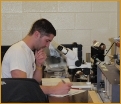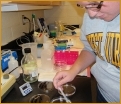Research: X. laevis
Xenopus laevis
Using an expression cloning strategy to isolate genes with lens-inducing activity, we isolated the previously identified transcriptional cofactor Xldb1. This, together with evidence for its nuclear dependence, suggested that its activity is due to an indirect mechanism. We thus proposed that Xldb1 mediates induction of an early lens gene in our functional assay by transcriptional activation of lens-inducing signals. Xldb1 was shown to be capable of activating genes of the presumptive lens, presumptive nose, and cement gland; however, it had not been demonstrated to be necessary for this process prior to our study. We microinjected morpholino oligonucleotides (MOs) directed against Xldb1 into zygotes, to block in vivo expression and study the role of Xldb1 in normal development. Our studies show that knocking down Xldb1 leads to decreased expression of early lens and retinal markers as assayed using in situ hybridization. We also show that their expression can be restored in MO injected embryos by rescuing with a truncated form of Xldb1 RNA that cannot be translationally blocked by the MO. The mortality rate in MO injected embryos was dramatically higher than in rescue RNA + MO coinjected embryos, suggesting the mortality was due to lack of Xldb1 activity and not MO toxicity. Surviving MO-injected embryos exhibited morphological abnormalities, most noticeably an enlarged cement gland. The data suggest that an Xldb1-regulated mechanism comprises the early signal for Xenopus lens induction.


